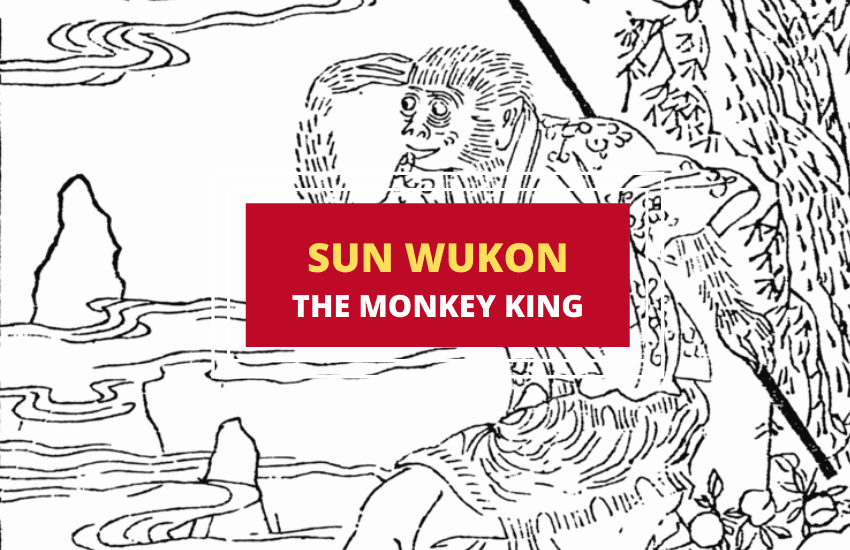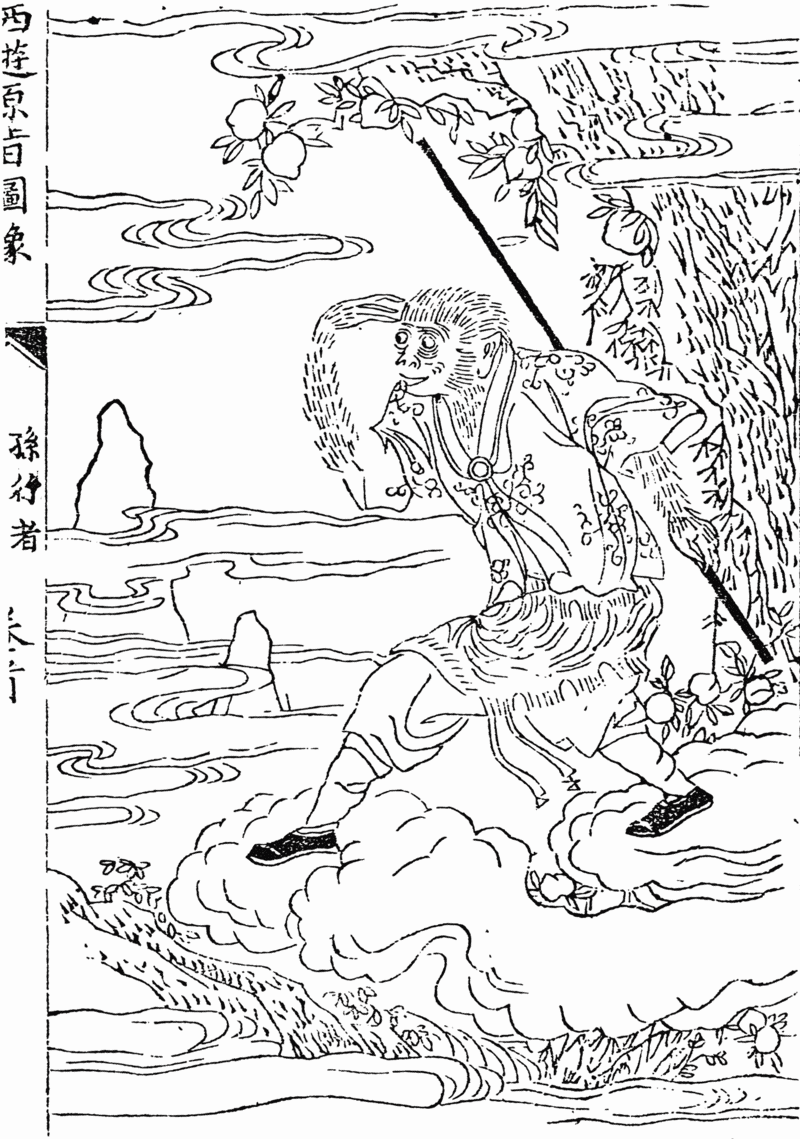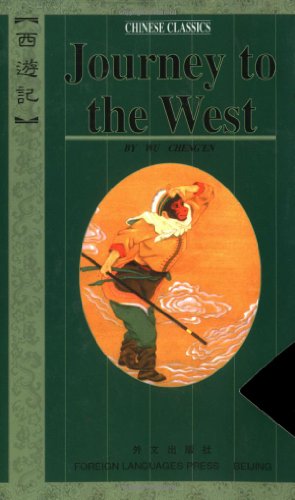
Table of Contents
Sun Wukong is one of the most famous characters of Chinese mythology, as well as one of the most unique deities in the world. A sentient monkey created by the Yin and Yang of the Universe itself, Sun Wukong’s long and colorful story is detailed in Wu Cheng’en’s 16th-century novel Journey to the West.
Who is Sun Wukong?

Sun Wukong, also known as the Monkey King, is a famous Chinese mythological/fictional character that journeys from China to India to reach Enlightenment. Sun Wukong goes through a lot of personal growth on that journey and his story is symbolic in many different ways.
Even though the Journey to the West novel was written (only) five centuries ago, Sun Wukong is viewed as a core character in Chinese mythology, albeit a new one.
Sun Wukong’s amazing powers
Before going into his story, let’s quickly list all the phenomenal abilities and powers Sun Wukong possessed:
- He had immense strength, enough to hold two celestial mountains on his shoulders
- Sun Wukong could run “with the speed of a meteor”
- He could jump 108,000 li (54,000 km or 34,000 mi) in one leap
- The Monkey King could transform himself into 72 different animals
- He was a great fighter
- Sun Wukong could also create copies or mirror images of himself
- He possessed weather manipulation abilities
- The Monkey King was also able to magically freeze people into position mid-fight
Some of these abilities Sun Wukong was born with, while others he developed or discovered on his travels. He also discovered many fantastic weapons and armor throughout his life, including his signature eight-ton staff weapon that could shrink to the size of a toothpick or grow into a giant weapon.
A Child of the Universe
The way Sun Wukong comes into being is both unique and somewhat familiar. The monkey was born inside a large magic stone that stood atop Mount Huahuo, or the Mountain of Flowers and Fruit. Part of the stone’s magic was that it receives nurture from Heaven (i.e. yang or “positive nature”) but it also receives nurture from the Earth (yin or “negative nature”).
The combination of these two Universal constants is what creates the life inside the stone similar to how Pan Gu, the Taoist creation deity, is created by yin and yang in the cosmic egg. In Sun Wukong’s case, yin and yang turned the magic rock into a womb within which an egg was hatched.
Eventually, the egg broke the stone and was left exposed to the elements. As the wind blew past the egg it turned into a stone monkey that immediately started crawling and walking. This origin story is similar to that of the Hindu Monkey deity Hanuman who was also born when the wind (or the Hindu God of Wind Vayu) blew upon a rock. At the same time, the inception of the egg from the yin and yang is a very Taoist concept.
To make his birth even more interesting, once Sun Wukong opened his eyes, two golden light beans started shooting out of them. The beams shone up toward the palace of the Jade Emperor in Heaven and startled the deity. Curious, the emperor sent two of his officers to investigate. When they returned they told him it was just a stone monkey and that the light died down when the monkey ate or drank water. Hearing this, the Jade Emperor quickly lost interest.
Left to his own devices, Sun Wukong eventually befriended some of the other animals on the mountain. As he grew, he also became more monkey-like, meaning that the stone turned into flesh and he grew a thick coat of hair. Growing among other monkeys and animals, Sun Wukong also managed to become their king or the so-called King of Monkeys after several feats, such as jumping into a waterfall and swimming upstream.
In that period of his life, Sun Wukong would also battle various enemies such as the Dragon King of the sea and various sea demons. He’d gather quite an inventory of weapons and armor from his enemies too, such as his magical and shrinking eight-ton staff, his cloud-walking boots, his phoenix feather cap, and his famous gold chainmail shirt.
The Trickster King of Monkeys
What earned Sun Wukong the moniker of “trickster” wasn’t just his playful and joyful personality, but how he saved his soul.
After spending some time as a King of Monkeys, Sun Wukong was visited by Yan Wang and the Ten Kings of Hell. It turned out that it was time for them to collect Sun Wukong’s soul.
The Monkey King was ready for this, however, and he tricked Yan Wang to let him go without killing him. What’s more, Sun Wukong managed to get hold of the Book of Life and Death. The Monkey King erased his name from the book and also removed the names of all other monkeys, essentially putting their souls beyond the reach of the Kings of Hell.
Yan Wang was enraged by this and joined the chorus of other voices defeated or tricked by Sun Wukong in pleading with the Jade Emperor to do something with the insolent monkey.
The Jade Emperor
As more and more demons and divinities started complaining about the testy Monkey King from Mount Huaguo, the Jade Emperor finally started to take notice. The ruler of the Heavens decided that the best way to deal with Sun Wukong was to let him live in Heaven with the other gods. The Jade Emperor hoped that this would satisfy Sun Wukong enough so that he’d stop causing trouble on Earth.
Wukong gladly accepted the Jade Emperor’s invitation and said goodbye to his monkey friends on Huaguo. Once he arrived at the Jade Palace, however, Sun Wukong was annoyed to find out that he’s been given the task of guarding the Emperor’s horses. He also found out that the other deities in Heaven mocked him for being a monkey and didn’t perceive him as their peer.
Sun Wukong couldn’t accept these insults so he decided to prove himself by finding the key to immortality. He devoted himself to this task for quite some time and would frequently ignore his other tasks and commitments as he viewed them as irrelevant.
One day, the Jade Emperor decided to throw a party for his wife, Xiwangmu. Sun Wukong wasn’t invited but that didn’t stop the Monkey King from showing up. When the other gods started mocking him and shushing him away, Wukong got even more irritated and decided to proclaim himself Qítiān Dàshèng or the Great Sage Equal to Heaven. This was a huge insult to the Jade Emperor as it essentially meant that Sun Wukong had declared himself the Emperor’s equal. The Monkey King even erected a banner with his new moniker written on it.
Infuriated, the Jade Emperor sent an entire battalion of soldiers to arrest the Monkey King but Wukong dispatched all of them with ease. After the last soldier was down, Wukong proceeded to mock the Emperor, shouting:
“Remember my name, Great Sage Equal to Heaven, Sun Wukong!”
The Jade Emperor did acknowledge Wukong’s victory after this and decided to make peace with the Monkey King. He offered him the position of a guard to Xiwangmu’s Peaches of Immortality. Sun Wukong still viewed this as an insult, however, so he decided to eat the Peach of Immortality instead.
Furious, the Emperor sent two more battalions after the Monkey Kin but those two were defeated easily. Eventually, the Jade Emperor was left with no other option but to ask the Buddha himself for help. As the Buddha saw Wukong’s egotistical antics, he banished the Monkey King from Heaven and pinned him under a mountain so heavy that even he couldn’t lift it.
Journey to the West
This is the part of Sun Wukong’s story that Journey to the West is actually named after. 500 years after the Monkey King was trapped under the mountain by Buddha, he was discovered by a traveling Buddhist monk named Tang Sanzang. The monk offered to free Wukong if the Monkey King promised to repent and become his disciple.
Still somewhat prideful even after 500 years of humiliation, Wukong refused – he wouldn’t be anyone’s servant. As Tang Sanzang started walking away, however, Sun Wukong had a quick change of heart and begged him to return. He agreed to gladly serve the traveling monk in exchange for his freedom. Tang Sanzang also agreed but asked the goddess of mercy Guan Yin to give him a magical band that would guarantee his control over the Monkey King.
Tang Sanzang then freed Sun Wukong and let him join his other two disciples – the part-human part-hog Zhu Bajie or “Piggy” and the disgraced former heavenly general Sha Wujing or “Sandy”.
Finally released, Sun Wukong was genuinely grateful to Tang Sanzang and joined him on his journey to the West. The journey of the pilgrim monk was actually to India where he wanted to search for some ancient Buddhist scrolls that would help him on his own road to Enlightenment.
The journey was long and perilous and Sun Wukong had to battle demons and other adversaries together with his new companions. He also received valuable lessons from Tang Sanzang along the way as well as from Piggy and Sandy. And, by the end of their travels, Sun Wukong managed to finally grow from the greedy, prideful, and angry monkey that he was to reaching Enlightenment.
Taoist, Hinduist, Buddhist, or Chinese?

Journey to the West. Buy it here on Amazon.
Even a surface read of Journey to the West reveals that the story takes inspiration from multiple different mythologies. The inception myth of Sun Wukong is very much of Hindu origin intertwined with the Taoist concepts of Yin and Yang.
The Jade Emperor and most of the rest of the gods in Heaven are also very much Taoist in origin. At the same time, however, they also recognize the Buddha as a powerful heavenly authority and the whole journey to India is in search of ancient Buddhist scrolls and the pursuit of Buddhist Enlightenment.
So, one can say that Buddhism is positioned as the main religion of the story while Taoism and, to an even greater extent, Hinduism are secondary. However, a more charitable reading would be that all of these religions, teachings, philosophies, and mythologies are viewed as a large collection called simply “Chinese mythology”.
Sun Wukong Throughout Asia
As Chinese mythology and most of the religions in the country are also present and active in other Asian countries, the story of Sun Wukong has also made its way throughout the continent. In Japan, the Monkey King is known as Son Goku, for example, while in Korea his name is Son Oh Gong. The story is popular throughout the rest of Asia as well, all the way to Vietnam, Thailand, and even Malaysia and Indonesia.
Symbols and Symbolism of Sun Wukong
Sun Wukong’s story exemplifies a person’s journey through life. From an infant to an adult and from Ego to Enlightenment, the mischievous Trickster and Monkey King is a metaphor for personal growth.
Born in a stone egg made out of pure Universal energies, Sun Wukong is powerful and divine from birth – just like all life is, according to Buddhism, Taoism, and most other Eastern philosophies. However, as a completely new and ignorant soul, Sun Wukong is also prideful, envious, and easily angered.
He hasn’t learned to reign in his Ego and has to spend 500 years under a rock, travel with a wise master, and face myriad challenges until he is able to grow as a person, understand his shortcomings, and attain Enlightenment.
Importance of Sun Wukong in Modern Culture
The origin of Sun Wukong is a written work of culture rather than a millennia-old oral myth. Wu Cheng’en wrote Journey to the West just five centuries ago, and yet Sun Wukong (or versions of him) has already found their way to various other literary and other works of art.
For one, the original novel has seen countless movie and theatrical adaptations. One of the most recent ones is the 2013 Journey to the West movie by Stephen Chow. Aside from that, there have been many characters based on Sun Wukong that have appeared in popular media including video games such as League of Legends, Marvel vs. Capcom 2: New Age of Heroes, Sonson, and Warriors Orochi.
A character by the name of Sun Wukong also appeared in Rooster Teeth’s future fantasy series RWBY. Probably the most famous example, however, is Son Goku, the main character in the Dragon Ball anime series. Named after the Japanese version of Sun Wukong, Son Goku also superhuman strength and a tail. He also favored fighting with a staff.
Wrapping Up
Sun Wukong is among the most unique figures of Chinese mythology, and the stories of his personal growth is one that contains many morals. It’s also a story that continues to inspire Chinese mythology, and modern culture in many ways.








